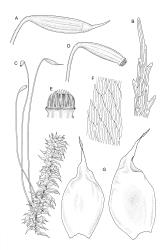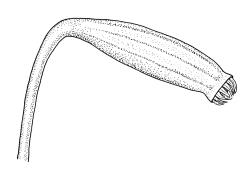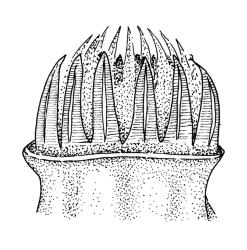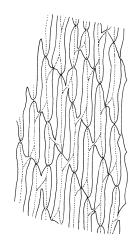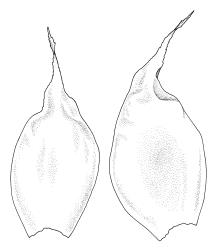- ≡ Hypnum aciculare Brid., Muscol. Recent. 2(2), 158, tab. 5, fig. 2 (1801)
Plants bright green, yellow-, or brown-green, lustrous, usually robust but quite variable in size, usually neat, occasionally rough and shaggy in appearance. Secondary stems ascendant, c. 30–120 mm, variably branched, stiff, red-brown, usually visible between leaves when dry except at shoot apices where obscured by imbricate leaves, in cross-section with many layers of thick-walled cortical cells and lacking a central strand. Leaves widely spreading, rather widely spaced in lower stems, much more closely spaced near stem apices, thin and chartaceous, little altered when dry, broadly ovate to broadly elliptic below, tapered to a narrowed insertion, abruptly contracted above to a broad, strongly toothed, and twisted acumen, not or indistinctly plicate, usually with an indistinct border in lower ½ of leaf of several rows of slightly enlarged cells, c. 3.0–4.5(–5.0) × 1.2–2.0 mm when well developed; mid laminal cells thick-walled and porose, mostly c. 35–50 µm, becoming longer towards insertion; cells at insertion shorter and pigmented in a band, those in alar angles irregular and thick-walled, forming small and weakly defined groups. Costae usually indistinct, double. Paraphyllia and gemmae absent.
Phyllodioicous in all but rare instances. Perichaetia scattered on ♀ stems, with inner leaves broadly oblong-obovate and abruptly tapered to an acumen, which is usually c. ⅓ the total leaf length, the outer leaves reflexed. Male plants usually dwarf and epiphyllic, occasionally well developed and with multiple scattered perigonia. Setae as per genus; capsules as per genus, c. 3.5–4.5 mm; annulus of several cell rows and persisting at capsule mouth, usually obscure or eroded; operculum with a very long and slender rostrum, ± equal the capsule. Exostome teeth yellow-brown, weakly shouldered above, furrowed, striate below (to top of the furrow) on outer surface, baculate at apex; endostome with cilia in pairs and 3s, well developed, appendiculate. Spores as per genus, 10–12 µm.
Beever et al. 1992, fig. 56; Brotherus 1925, fig. 514; Kühnemann & Gonçalves Carralves 1975, Pls. VI–VII; Malcolm & Malcolm 2003, p. 56; Milne & Klazenga 2012, unnumbered fig. and photos; Seppelt et al. 2013, pl. 23.
NI: N Auckland, including offshore islands (TK, PK, HC, LB), S Auckland, Gisborne, Hawke’s Bay, Taranaki, Wellington; SI: Nelson, Marlborough, Canterbury, Westland, Otago, Southland; St; Ch; Sol; Sn; A; Ant, C. No material has been seen from M, and Seppelt (2004) concluded that this species does not occur there.
Predominantly austral but extending north to Malesia and Pacific Is. Tasmania*, mainland Australia (N.S.W.* Vic*), Lord Howe*, Argentina*, Chile*, Tahiti*, Fiji*, Borneo*. Milne & Klazenga (2012) recorded it from the state of South Australia and Belleden Ker in Queensland. Reported from Samoa, Hawai‘i, and New Caledonia by Kühnemann & Gonçalves Carralves (1975) and from the Marquesas Is. and from Rapa I. (Whittier 1976, p. 231). Whittier specifically questioned the occurrence of this species in Hawai‘i.
This is one of N.Z.’s most widespread and frequent moss species, and it is one of few indigenous moss species with a well-established common name: the apt "pipe-cleaner moss". Ptychomnion aciculare forms dense and often extensive wefts on humus and duff in a variety of forest types, but is best developed and most abundant in forest dominated by one or more species of southern beech, Kunzea spp., or Leptospermum scoparium. It is often a prominent ground cover species in these forest types. Also occurring, sometimes abundantly, in Agathis australis or Weinmannia spp. dominated forests and in podocarp or podocarp/broadleaved forests. In addition to its occurrence on the forest floor, P. aciculare occurs commonly on stumps and rotten logs and epiphytically, as well as in grasslands and under exotic tree species. Ranging from near sea level to at least 1070 m (Ruahine Range, Hawke’s Bay L.D.) on the North I. and to c. 1120 m (Paparoa Range, Nelson L.D.) on the South I.
This distinctive and attractive species is extremely variable in stature, ranging from plants only c. 15–20 mm to c. 120 or more mm long. The usually yellow-green colour, broadly ovate, abruptly narrowed, and chartaceous leaves with their twisted and toothed apices, together with the strong tendency for the leaves to be more crowded at the branch apices, make this one of the most readily recognised mosses in N.Z. The red-brown stem is wiry and nearly always visible between the lower leaves of the stem, thus readily differentiating this species from its sole N.Z. congener. Scott & Stone (1976, p. 360), writing on the Australian flora, refer to it as "perhaps the most unmistakable moss in the entire flora; there is nothing like it".
Ptychomnion aciculare is consistently dioicous, with the ♂ plants usually greatly reduced in size and epiphyllic on leaves of the robust female plants. Occasionally the dwarf male plants can be observed with a hand-lens in the field, and are most likely seen in abundantly fruiting populations. However, the degree of ♂ plant development varies, suggesting developmental inhibition by growth substances produced by ♀ plants. Perigonia have been seen on well-developed ♂ shoots in material from N Auckland L.D., Stewart I., and Chatham I.
The degree of endostomal development is likewise variable. The majority of populations have well-developed and perforate segments and two to three appendiculate cilia. However, material has been seen with segments lacking and rudimentary cilia.




